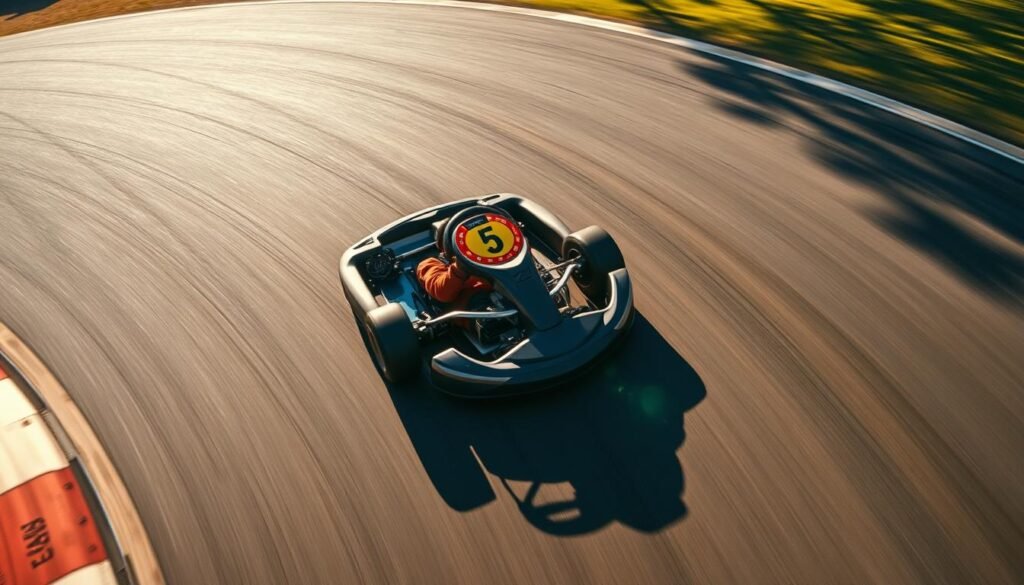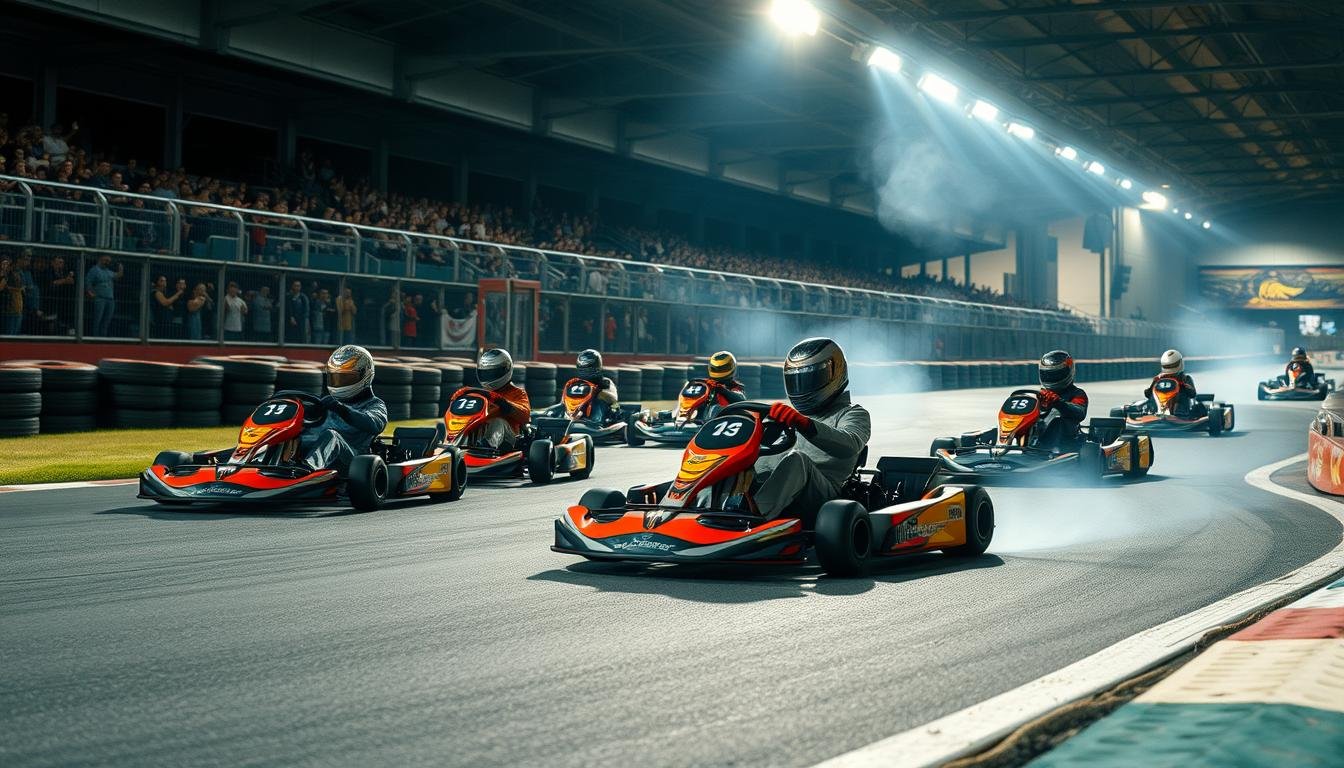Go-kart racing blends raw speed with precise technique, demanding more than just casual driving skills. While recreational karting focuses on fun, competitive racing requires mastering fundamentals like weight distribution, cornering control, and throttle management. These elements separate weekend drivers from those chasing podium finishes.
Success on the track starts long before the green flag drops. Proper kart setup adjustments—like tire pressure and gear ratios—directly impact lap times. Even small tweaks can unlock hidden performance, especially when paired with strategic racing lines that maximize momentum through turns.
This guide breaks down core strategies used by professional racers. You’ll learn how to optimize entry/exit speeds, conserve tire grip, and execute overtakes without sacrificing stability. Whether you’re preparing for your first race or refining advanced tactics, these methods deliver measurable improvements across any circuit.
Key Takeaways
- Precision kart adjustments boost speed and handling
- Optimal racing lines conserve momentum through corners
- Throttle control prevents wheel spin during acceleration
- Strategic braking zones maintain competitive lap times
- Weight shifting techniques improve cornering stability
Introduction to Go-Kart Racing
Go-kart racing merges split-second decisions with physical precision, creating a sport where milliseconds define success. Unlike traditional motorsports, drivers experience unfiltered feedback through their seat and steering wheel, making every adjustment critical.
Understanding the Thrill and Technique
The excitement of wheel-to-wheel racing comes from mastering three core elements: grip management, weight shifts, and vision. Novices often focus solely on speed, while seasoned drivers prioritize smooth inputs and predictive line selection. This technical approach separates recreational laps from competitive results.
Why Improvement Matters for Every Racer
Advancing your skills directly impacts performance. For example:
- Adjusting tire pressure by 1 PSI can alter cornering speeds
- Shifting body weight 2 inches changes traction distribution
- Perfecting braking zones saves 0.3 seconds per lap
These micro-improvements compound over races. Professional karting coaches emphasize that consistent refinement of technique builds muscle memory – the key to adapting across diverse tracks and weather conditions.
Preparing for the Race: Position, Setup, and Attire
Race-day success starts with how you interact with your machine. Every adjustment to your body’s position and gear choice directly impacts how the kart responds. Ignoring these details can leave seconds on the track – time you’ll never reclaim.
Adjusting Your Seat and Pedal Reach
Locate the lever beneath the seat’s front edge. Slide forward until your legs bend slightly when fully pressing the pedals. This setup ensures complete throttle control without straining your knees. Keep hands at 9 and 3 o’clock positions – this symmetrical grip lets you steer smoothly through hairpin turns.
Test your reach before hitting the track. Can you turn the wheel 180 degrees without leaning? If not, readjust. Proper alignment reduces fatigue and keeps inputs precise during critical overtakes.
Selecting Light and Performance-Enhancing Gear
Physics doesn’t lie: lighter total weight means faster acceleration. Swap bulky jackets for moisture-wicking shirts and choose thin-soled shoes for better pedal feedback. Racers wearing breathable materials often maintain focus longer in heated competitions.
Consider these upgrades:
- Flexible gloves for improved steering grip
- Snug helmets reducing wind resistance
- Elastic waistbands allowing fluid weight shifts
Every ounce saved translates to quicker lap times. Combine smart gear choices with ergonomic adjustments, and you’ll feel the kart respond like an extension of your body.
Top 5 Tips to Improve Your Go-Kart Racing Skills
Dominating the track requires methodical preparation and razor-sharp execution. These five core strategies transform raw speed into repeatable results, helping drivers consistently shave seconds off their performance.
Optimize Driver Positioning
Adjust your seat until knees flex slightly at full pedal extension. This stance ensures precise throttle control during acceleration. Keep hands locked at 9 and 3 o’clock—this grip prevents oversteering through tight corners.
Reduce Unnecessary Weight
Every pound impacts acceleration. Wear moisture-wicking fabrics and thin-soled shoes for better pedal feedback. Professional racers often shed 2-3 pounds of gear to gain measurable speed advantages.
Execute the Ideal Racing Line
The fastest path through corners follows a precise geometric pattern. Approach wide, clip the inside apex, then drift outward. lap times by up to 1.5 seconds.
Perfect Braking Discipline
Stomp-and-release braking wastes momentum. Instead, apply gradual pressure before turns while keeping throttle inputs smooth. This technique preserves tire grip, letting you accelerate earlier on exits.
Smart Overtaking Tactics
Study opponents’ lines during practice laps. Capitalize on their late braking or wide exits. Time passes for the inside line during hairpins—this high-risk move demands split-second commitment but delivers decisive advantages.
Mastering the Racing Line and Cornering Techniques
Precision in corner navigation separates contenders from champions on the karting circuit. The fastest path through bends combines geometry with physics, demanding exact steering inputs and body discipline. Even minor deviations from optimal trajectories can cost seconds per lap – gaps that become insurmountable in tight races.

Navigating Corners with Optimal Speed
The racing line follows an out-in-out pattern: enter wide, clip the apex, then drift outward. This approach reduces steering angles while maintaining momentum. Key factors include:
- Braking early enough to hit the turn-in point
- Timing throttle application as you pass the apex
- Adjusting lines for different corner types (hairpins vs. sweepers)
Drivers who master this technique gain 0.8-1.2 seconds per lap through complex sections. Visualize turns before reaching them – your eyes should always lead the kart’s position.
Maintaining Weight Balance Through Turns
Leaning into corners disrupts traction by shifting weight toward inner wheels. Instead, stay centered in the seat. This keeps all four tires evenly loaded for maximum grip. Practice these methods:
- Lock elbows against the seat bolsters during sharp turns
- Use core muscles to resist lateral forces
- Gradual steering inputs prevent sudden weight transfers
Proper balance lets karts rotate smoothly through corners without fishtailing. Combine this with precise line selection, and you’ll exit turns at championship-winning speed.
Enhancing Your Braking and Acceleration Techniques
Mastering brake and throttle control unlocks hidden performance in competitive karting. These twin skills determine how effectively you maintain speed through corners while preparing for explosive exits. Unlike casual driving, professional techniques demand split-second coordination between footwork and steering inputs.
Braking Strategies for Maximum Control
Effective braking technique starts with timing. Apply pressure gradually 15-20 feet before turns, not during steering. This keeps weight balanced across all tires. Braking in straight lines prevents skidding – a critical error that bleeds momentum.
Follow the “slow in, fast out” principle. Reducing entry speed lets you accelerate harder at corner exits. Avoid late braking that forces abrupt corrections. Top racers complete 90% of braking before turning the wheel.
Early Acceleration and Smooth Throttle Control
Initiate throttle input just before reaching the apex. This builds momentum early without overloading rear tires. Gentle pedal pressure maintains traction – stomping causes wheel spin that kills lap times.
Practice these acceleration essentials:
- Feed power gradually as you unwind the steering
- Keep feet disciplined – never press both pedals simultaneously
- Adjust throttle based on track temperature and tire wear
Combining precise brake control with calculated acceleration creates seamless transitions between corners. These methods shave tenths off every lap – the difference between podium finishes and mid-pack results.
Overtaking Strategies and Onboard Study
Strategic overtaking separates confident competitors from hesitant participants in kart racing. Success requires analyzing both the track and your opponent, transforming observation into decisive action. Seasoned drivers combine real-time reactions with pre-race preparation to execute passes that preserve momentum.
Observing Fast Drivers and Studying Track Layouts
Arrive early to watch practice sessions with a purpose. Focus on competitors using similar kart setups, noting their braking markers and corner-entry speeds. Top performers often reveal optimal lines through complex sections – details invisible from static diagrams.
Modern racers supplement trackside observation with driving simulators and onboard footage. Study how professionals adjust their strategy for specific turns. Look for patterns in throttle application and steering corrections during overtakes.
Techniques for Clean and Efficient Passing
The golden rule: “If your front bumper touches their rear, you’re positioned to pass.” Execute this in heavy braking zones by delaying your stop slightly. Target the inside line – this forces opponents to choose between collision or conceding position.
Effective overtaking demands three elements:
- Predicting rival drivers’ exit trajectories
- Maintaining tire grip through partial-throttle phases
- Timing acceleration to block counterattacks
Review post-session video footage to identify missed opportunities. Compare your lines against faster competitors, focusing on how they set up passes over multiple laps.
Advanced Go-Karting Techniques for Improved Lap Times
Elevating your performance requires rethinking how you interact with the steering wheel. Many drivers lose precious tenths by making unnecessary hand movements – a habit that disrupts control and tire grip. Professional racers maintain fixed positions at 9-3 or 8-4 o’clock, using core muscles rather than arms for precise inputs.
Refining Your Cornering and Steering Method
The push-pull technique revolutionizes corner navigation. Pull down with your inside hand while pushing up with the outside – this engages stronger back muscles for smoother turns. Hands stay glued to the wheel, eliminating wasted motion that causes oversteering.
Modern karts need minimal steering input thanks to responsive systems. Full lock positions handle any corner without hand shuffling. Focus on gradual adjustments – sudden jerks upset weight balance and scrub speed.
Three steering essentials cut lap times:
- Locked wrist positions prevent grip changes mid-turn
- Shoulders relaxed to absorb vibrations through the chassis
- Thumb anchors against wheel spokes for precise angle control
Advanced drivers feel traction limits through steering feedback. This sensitivity allows micro-corrections without sacrificing the racing line. Pair these methods with vision-focused practice sessions, and you’ll see consistent time drops across technical sections.
Common Mistakes and Pitfalls in Go-Kart Racing
Even skilled drivers often undermine their performance through preventable errors. Small technical flaws compound over laps, turning minor issues into race-costing weaknesses. Steering miscalculations and braking missteps rank among the most frequent setbacks for amateur racers.
Avoiding Improper Steering and Braking Errors
Death-gripping the wheel creates tension that slows reaction times. Keep hands relaxed at 9-3 o’clock, using your shoulders to initiate turns. Excessive hand shuffling mid-corner disrupts balance and scrubs speed.
Braking mistakes often stem from poor timing. Many drivers brake too softly in wet conditions, causing understeer. Others stomp pedals during turns, shifting weight abruptly. Always complete 80% of braking before entering corners.
Maintaining Consistency and Analyzing Performance
Review telemetry data to spot patterns across laps. Does your line drift wider on left-hand turns? Are brake pressures inconsistent? Identifying these weaknesses helps create targeted fixes.
Top racers film practice sessions to study body positioning and wheel inputs. Compare your techniques against faster drivers, focusing on how they maintain balance during aggressive maneuvers. Small adjustments here yield big gains.

Ramon Splinter is a passionate go-kart enthusiast and expert who shares valuable tips and insights on Zyorb, a blog dedicated to karting enthusiasts. With years of experience on the track, he specializes in helping beginners and seasoned drivers improve their skills, optimize their karts, and master racing strategies. His articles combine technical knowledge with practical advice, making go-karting more accessible and exciting for all.

